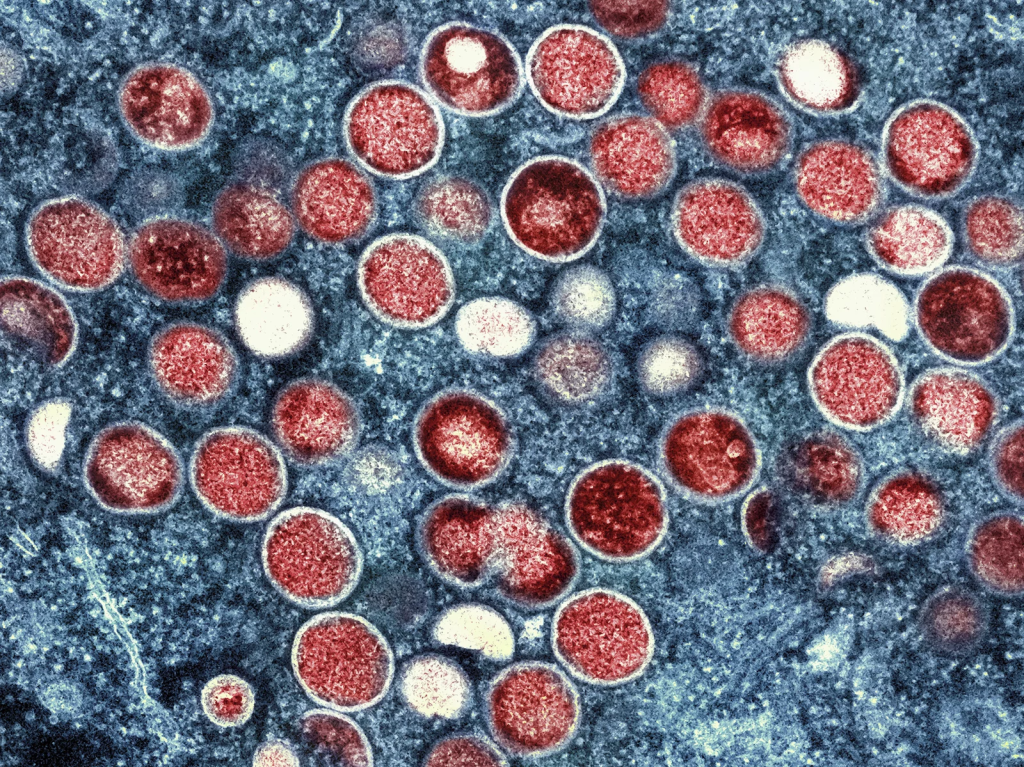
A colorized transmission electron micrograph of monkeypox particles are seen in red. Image: National Institute of Allergy and Infectious Diseases Integrated Research Facility
The Biden Administration Declares Monkeypox a Public Health Emergency
August 4, 2022
Source: National Indian Health Board
The Department of Health and Human Services (HHS) Secretary, Xavier Becerra, has declared the current monkeypox outbreak a Public Health Emergency as the number of confirmed monkeypox cases surpasses 6,000, based on the Centers for Disease Control and Prevention (CDC) counts. President Biden’s decision to declare monkeypox a public health emergency allows him to raise awareness of the virus and unlock more flexibility for spending on ways to treat and tackle the virus. Public health emergencies last 90 days but can be extended by the Secretary.
Anyone can get monkeypox. Monkeypox can spread through sexual activity and direct skin-to-skin contact, such as hugging and kissing and sharing bedding, clothing, or towels. It can also spread through large respiratory droplets from infected people but is much more difficult to transmit through this route than COVID is.
“We’re prepared to take our response to the next level in addressing this virus,” Becerra said Thursday. “We urge every American to take monkeypox seriously and to take responsibility to help us tackle this virus.” Dr. Rochelle Walensky, the CDC Director, said the declaration will help “exploit the outbreak” and potentially increase access to care for those at risk.
Nearly every state in the U.S.—except for Montana and Wyoming—has reported at least one confirmed monkeypox case. Governors in California, New York, and Illinois declared an emergency in response to the monkeypox outbreak in the last two weeks. Some cities, including New York City and San Francisco, have made emergency declarations. The number of cases for American Indians and Alaska Natives is not available as cases have not been reported by race. According to the CDC data on July 25, 2022, 38 percent (n=524) of patients with known race/ethnicity were white/non-Hispanic, 26 percent (n=358) were Black, and 32 percent (n=445) were Hispanic (of any race). Data are missing for a large number of cases, including the American Indian/Alaska Native populations.
Dr. Robert Califf, the Food and Drug Administration commissioner, said the U.S. is “at a critical inflection point” in the monkeypox outbreak, requiring “additional solutions to address the rise in infection rates.” U.S. health officials said 800,000 monkeypox vaccine doses would be available for distribution. But in hotspot states for the monkeypox outbreak, there’s a drastic disconnect between the number of doses local health officials say they need and what they have been allotted. JYNNEOS and ACAM2000 are two monkeypox vaccines currently available in the United States via the Strategic National Stockpile.
The National Indian Health Board is communicating with the Indian Health Service (IHS) and the Centers for Disease Control and Prevention (CDC) and will provide updates as available. If you have any immediate questions, please contact Public Health Policy and Programs Project Coordinator Audrianna Marzette at amarzette@nihb.org.
Resources
- U.S. Monkeypox 2022: Situation Summary
- Monkeypox Signs and Symptoms
- What Health Professionals Need to Know About Monkeypox
- Frequently Asked Questions
